Characteristics
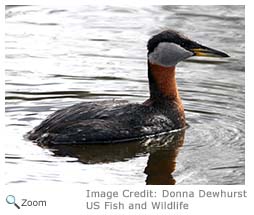 The red-necked grebe is a medium-sized aquatic bird that is 13-17 inches in length with a wingspan of around 32 inches. It has a long neck; a straight, long black bill that is yellow at the base; and black legs and feet that are set far back on its body. It has a black cap, grayish-white cheeks, and a brown body. During breeding season it has a rusty red neck and breast. In the non-breeding season it has a gray neck and breast. Young red-necked grebes have black and white zebra-striped heads and necks. Males and females look alike, but males are a little larger. The red-necked grebe is a medium-sized aquatic bird that is 13-17 inches in length with a wingspan of around 32 inches. It has a long neck; a straight, long black bill that is yellow at the base; and black legs and feet that are set far back on its body. It has a black cap, grayish-white cheeks, and a brown body. During breeding season it has a rusty red neck and breast. In the non-breeding season it has a gray neck and breast. Young red-necked grebes have black and white zebra-striped heads and necks. Males and females look alike, but males are a little larger.
Range
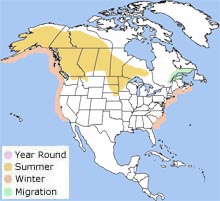 The red-necked grebe's breeding ground runs from Alaska and northern Canada south to Oregon, Idaho, southern Minnesota and Ontario. It winters along both coasts south to California and Georgia It is also found in Europe and Asia. The red-necked grebe's breeding ground runs from Alaska and northern Canada south to Oregon, Idaho, southern Minnesota and Ontario. It winters along both coasts south to California and Georgia It is also found in Europe and Asia.
Habitat
 The red-necked grebe lives in marshy ponds and lakes in summer. In the winter and during migration it can be found on large lakes, coastal bays and estuaries. The red-necked grebe lives in marshy ponds and lakes in summer. In the winter and during migration it can be found on large lakes, coastal bays and estuaries.
|
|
Diet
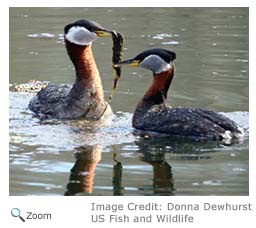 The red-necked grebe eats minnows and other small fish, crayfish, tadpoles, salamanders, insects, and aquatic plants. When it is looking for food, it often swims with its head underwater and then dives when it spots food. Sometimes it scoops up food from the surface of the water. The red-necked grebe eats minnows and other small fish, crayfish, tadpoles, salamanders, insects, and aquatic plants. When it is looking for food, it often swims with its head underwater and then dives when it spots food. Sometimes it scoops up food from the surface of the water.
Life Cycle
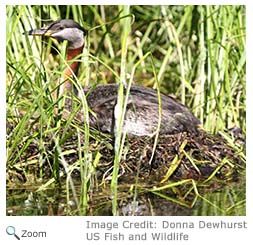 The female red-necked grebe lays two to six eggs. The nest is made on a floating mass of reeds and grass. The eggs hatch in about three weeks. The chicks fledge when they are between 50 and 70 days old. Both parents care for the young. The female red-necked grebe lays two to six eggs. The nest is made on a floating mass of reeds and grass. The eggs hatch in about three weeks. The chicks fledge when they are between 50 and 70 days old. Both parents care for the young.
Behavior
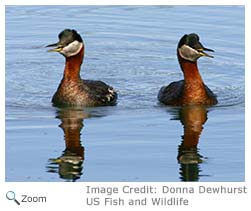 The red-necked grebe is a great diver and swimmer. It often swims with just its head above the water. It rarely leaves the water for land and, with the exception of when it is migrating, it rarely flies. The red-necked grebe is a great diver and swimmer. It often swims with just its head above the water. It rarely leaves the water for land and, with the exception of when it is migrating, it rarely flies.
|